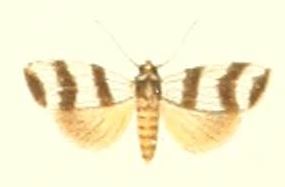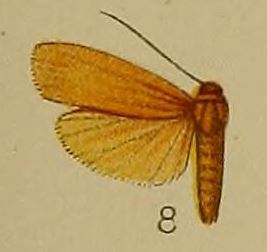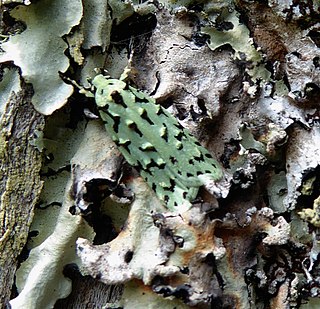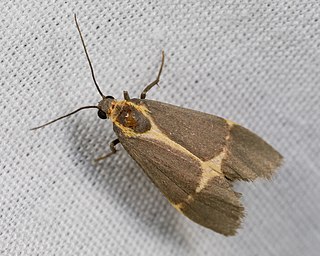
The geometer moths are moths belonging to the family Geometridae of the insect order Lepidoptera, the moths and butterflies. Their scientific name derives from the Ancient Greek geo γεω, and metron μέτρον "measure" in reference to the way their larvae, or inchworms, appear to measure the earth as they move along in a looping fashion. A very large family, it has around 23,000 species of moths described, and over 1400 species from six subfamilies indigenous to North America alone. A well-known member is the peppered moth, Biston betularia, which has been subject of numerous studies in population genetics. Several other geometer moths are notorious pests.

Eutane is a genus of moths in the subfamily Arctiinae. The genus was erected by Francis Walker in 1854.

Katha depressa, the buff footman, is a moth of the family Erebidae found in Asia and Europe. It was first described by Eugenius Johann Christoph Esper in 1787.

Palaeosia is a monotypic moth genus in the family Erebidae erected by George Hampson in 1900. Its only species, Palaeosia bicosta, the two-ribbed arctiid or two-ribbed footman, was first described by Francis Walker in 1854. It is found in south-eastern Australia.

Termessa nivosa is a moth of the subfamily Arctiinae first described by Francis Walker in 1865. It is found in the Australian states of New South Wales, South Australia and Victoria.

Brunia antica is a moth of the family Erebidae described by Francis Walker in 1854. It is found from the Indian subregion, Sri Lanka to China, the Ryukyu Islands, the Chagos Archipelago, the Nicobar Islands and Sundaland.

Izatha peroneanella, also known as the small lichen moth or the green lichen tuft, is a moth of the family Oecophoridae. It is endemic to New Zealand, where it is found throughout the North Island, other than the Aupouri Peninsula of Northland.

Anestia ombrophanes, the clouded footman, is a moth of the subfamily Arctiinae. The species was first described by Edward Meyrick in 1886. It is known from the Australian Capital Territory, New South Wales, Queensland, Western Australia, Victoria and South Australia.

Manulea replana, the lichen-eating caterpillar or lichen moth, is a species of moth of the subfamily Arctiinae. It is found in Australia.

Lyclene structa is a species of moth of the subfamily Arctiinae first described by Francis Walker in 1854. It is found in the southern half of Australia.
Scopula perlata, the cream wave, is a moth of the family Geometridae. The species was first described by Francis Walker in 1861. It is found in Australia, as well as Indonesia.
Castulo plagiata, the yellow-banded footman, is a moth of the subfamily Arctiinae. The species was first described by Francis Walker in 1854. It is found in the Australian states of New South Wales, Victoria and Tasmania.
Halone sinuata, the rock lichen moth, is a moth of the subfamily Arctiinae. It was described by Wallengren in 1860. It is found in Australia.

Cisthene barnesii, or Barnes' lichen moth, is a moth of the family Erebidae. It was described by Harrison Gray Dyar Jr. in 1904. It is found in the US Rocky Mountain region, from southern Montana and western North Dakota to the border with Mexico in Arizona and New Mexico. The habitat consists of dry bunchgrass steppe.
Cisthene liberomacula is a moth of the family Erebidae. It was described by Harrison Gray Dyar Jr. in 1904. It is found along the coast of the US state of California. The habitat consists of areas with coastal live oaks.

Pygoctenucha terminalis, the blue-green lichen moth, is a moth in the family Erebidae. It was described by Francis Walker in 1854. It is found in Mexico and in the United States in eastern Colorado, New Mexico and southeastern Arizona.
Schistophleps albida is a moth in the family Erebidae. It was described by Francis Walker in 1864. It is found in Australia and New Guinea.
Termessa catocalina is a moth in the subfamily Arctiinae. It was described by Francis Walker in 1865. It is found in Australia, where it has been recorded from New South Wales and Victoria.
Termessa gratiosa is a moth in the subfamily Arctiinae. It was described by Francis Walker in 1865. It is found in Australia, where it has been recorded from the Australian Capital Territory, New South Wales, Queensland and Victoria.

Elophila responsalis is a moth in the family Crambidae. It was described by Francis Walker in 1866. It is found in Australia, where it has been recorded from Queensland.










